22
Original news desk of Harry J. Boyle1935-1941
920 CKNX, Wingham, Ontario
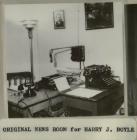 Credits:
Credits:Wingham Library, Wingham, Ontario
Wingham Professional Businesswomen's Association
23
Expansion ...In 1937, CKNX got permission to step up the power from 50 to 100 watts. At this point the staff increased to 7 members. "It was then that the community service policies of the station were laid down. It was quite evident that to survive, programs had to be geared to the needs of the listener." All news - no matter what was going on in the world - was to have a 50% local content. Talent, wherever possible was to be live and local. (25th Anniversary, 1951)
Funeral Announcements - CKNX pioneered another service that originally caused some eye-brows to lift, but it quickly became the most listened-to show on the station, and it remains so today. "Funeral Announcements" began in those early days of CKNX and to this day remains one of the few programs as a station service without a commercial sponsor. (Carbert essay, 1995) p. 14
Public Services - The funeral directory was only one of a multitude of public services offered by CKNX Radio, weather reports, road advisories, school closings, meeting announcements and postponements, fairs and plowing matches. Service clubs were the recipients of many free-time donations, such as the Kinsmen's Radio Auction, the Salvation Army's Red Shield fund raising drive. In fact, on more than one occasion Doc Cruickshank served as co-ordinating chairman of that Red Shield Drive. But perhaps the most extensive and widely recognized public service was the provision of a mobile public address system for local fairs and exhibitions. This started in the mid-40s, and consisted of the station providing a mobile P.A. system, mounted on the roof of one of the station vehicles, parked in the center of the fair grounds, so the sound could be heard in every corner. Tory Gregg became one of western Ontario's best known personalities by acting as Master of Ceremonies - Race Starter, at a host of fall and spring fairs, and Elmer Purdon, who had for years been the unseen and unheralded technical operator for the Saturday night Barn Dance, became a fixture with this mobile unit. In the mid 50s when Tory accidentally found himself double-booked for several dates I(Bob Carbert) was pressed into service with a back-up sound system and for as long as I remained at CKNX I continued to serve in this capacity at a dozen or so annual fairs.
In more recent years, CKNX became very well known for its service to the International Plowing Match, providing the mobile sound system and message service throughout the "Tent City". These services were carried out by Pete Hollinger, and especially by Roy Bennett, who served the station and the public well for many years. (Carbert essay, 1995) p. 14
24
Radio announcer, Doug Fry, at the radio master control panel in the CKNX radio stationcirca 1946
920 CKNX, Wingham, Ontario
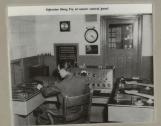 Credits:
Credits:North Huron Museum, Wingham, Ontario
25
More Power ...During the year 1940, when CKNX was endeavouring to get an increase in power and a better wave length, Mr.Robert Deachman, who was then Federal member for North Huron, arranged for many interviews with radio authorities. (25th Anniversary, 1951) The push for more power was ultimately successful. In 1941, a new 100 watt transmitter and antennae were installed on Highway 4, south of Wingham. (MM, 159) When permission was granted to increase power to 1,000 watts, the station's popularity grew in this expanded broadcast area, largely because of its use of live talent, and the 'Barn Dance' was perhaps the finest example of this. (Carbert essay, 1995)p.2f
By 1941, Wingham was calling itself "The Radio Town of Canada." CKNX staff numbered 13. Gross revenue was $27,000. A down payment on the new 1,000 watt transmitter was made. (100yrs, 22) The station became a full-time job for Doc and he operated from a room in the Brunswick Hotel, a structure no longer standing. (LFP-5, 1970) "By 1941 revenue had reached $27,000 a year. Doc managed to save $2,200 and it served as a downpayment to RCA Victor who took a chance on the small-town entrepreneur and installed a new $30,000 transmitter. A piece of land was purchased a few miles south of town for the transmitter site. A transmitter house was built. Studios were enlarged and modernized. When the commercial license was gained the station had jumped in power from 50 to 100 watts. Now the jump was to be to 1000 watts and the frequency was to change from 1200 at one end of the dial to 920 kilocycles at the middle of the dial. (50 years, 1976, p.6) (VS-1, 1976)
The studios were enlarged and hundreds of smaller improvements added until the cost ran up to around $30,000. (25th Anniversary, 1951)
The studio was redone - there was a green tile front put on the CKNX station. The main studio lives up to the promise of the 'gay front and the guests are inevitably delighted with the well-appointed station. When in Wingham, plan on a half hour or fifteen minutes to be spent with the CKNX staff." (CKNX Almanac-5, 1942 p.5)
26
Exterior of CKNX on Josephine Street, Wingham - circa 1940s1940s
Original radio station, Josephine Street, Wingham, Ontario
 Credits:
Credits:North Huron Museum
27
Interior of the original radio station located on Josephine Street, Wingham, Ontario1930s
Original radio station, Josephine Street, Wingham, Ontario
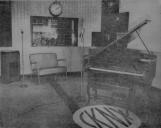 Credits:
Credits:North Huron Museum, Wingham, Ontario
28
Importance of the Transmitter ...The broadcasting equipment of a radio station is divided roughly into two sections, the studio equipment and the transmitting equipment. In the case of CKNX, the former is located in the studios in Wingham and the latter in the transmitting building on No. 4 highway, just north of Belgrave. The studio equipment is comprised of a control panel, numerous amplifiers, volume controls, switches, indicator lights, telephone jacks, etc; four turntables for playing recordings and transcriptions; an emergency 100 watt transmitter and an emergency gasoline driven power generator for use during hydro failures. (25th Anniversary, 1951)
A look now at the equipment at the transmitting site discloses something of a similar nature but on a larger scale. The transmitter building houses the transmitter proper, a piece of radio equipment 10 feet long, 7 feet high and 2 feet deep, weighing 1 ½ tons. It is this equipment that actually put the program "on the air". The radio tubes used, between 50 and 60 in number, vary in size from those one inch high to those twelve inches high and six inches in diameter. To radiate 1000 watts into the air, this equipment consumes almost 6000 watts of power from the hydro lines. The radiating elements themselves are two steel towers 187 feet high and lined up in a north-south direction. An intricate ground system is necessary for broadcasting and that of CKNX consists of between 9 and 10 miles of buried copper wire fanning out like the spokes of a wheel from the bases of the two towers. (25th Anniversary, 1951)
The question is frequently asked as to why the station wasn't built on a nearby hill. The excellent grounding conditions available on the marshy land in the valley where the transmitting site is located, far outweighs the extra fifty or sixty feet additional altitude a location on the hill would offer. (25th Anniversary, 1951)
CKNX requires two towers for one reason only and that is to beam our program northerly at night in order not to interfere with a station in West Virginia, which is also on 920 Kc. This protection is required by an International Radio Agreement which gives the West Virginia station a priority on this frequency because they are using it before CKNX was assigned to it also. This protection is required only at night. Consequently only one of our two towers is used during the day and our signal is sent out equally in all directions. It should be made clear that there is no reduction of power at night, only a beaming in a northerly direction. What is reduced in the south is gained in the north. In addition to this however, the West Virginia Station more than doubles its power in our direction at night. These two facts account for the periodic interference on the CKNX frequency after sundown. (25th Anniversary, 1951)
29
In 1941, CKNX radio built a new 100 watt transmitter house and tower, 4 miles south of Wingham.1935
920 CKNX, Wingham, Ontario
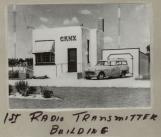 Credits:
Credits:North Huron Museum, Wingham, Ontario
Wingham Professional Businesswomen's Association
30
Early staff of CKNX radio standing outside the original station, Josephine Street, Wingham, Ontario.1940s
920 CKNX, Wingham, Ontario
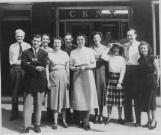 Credits:
Credits:North Huron Museum, Wingham, Ontario
31
Commitment to Local Content ..."The commitment from the beginning was toward local programming. It was evident that to survive, the station was going to have to offer something the larger stations couldn't, so Doc pushed his station toward local programming. All news, no matter what was going on in the world, was to have a 50 per cent local content. Talent used in shows wherever possible would be live and local." (50 years, 1976, p.6) (VS-1, 1976)
Local group - Early Birds (aka Ranch Boys) - The Early Birds/Ranch Boys - stars of the morning show, old favorites with CKNX listeners -
CKNX Ranch Boys and Early Birds are one and the same band with the exception of Bob Hall. Bob does not appear with the Early Birds, but he is replaced by Pauline Swanson who "has sung her way into the hearts of numerous members of our audiences." (CKNX Almanac-2, 1942) Here is a sample of a letter sent to the station - Letter(CKNX Almanac - July 1942)
Drumbo, Ontario - July 1942
Dear Sirs,
Enclosed you will find 25 cents for a years subscription to the CKNX Almanac. …I enjoy your programs very much especially the Gene Autry one on Sunday's and the Early Birds. ….
P.S. What ever you do keep little Pauline singing with the Early Birds. (CKNX Almanac-4, 1942 p.2)
CKNX Hillbillies vs CKNX Ranch Boys - In 1940, an outfit known as the CKNX Ranch Boys were rivaling for listener affection with another CKNX group known as the Hillbillies. Both were good musical aggregations and letters flowed through the mail equally well for both. The CKNX Hillbillies were an older bunch than the Ranch Boys having been on the air since 1939 and featuring Cec Merkley, better known now as "Shorty" of the Early Birds, Bill (Ernie Karges) and Pete (Bob Hall). Bob is with the present Ranch Boys while Ernie has left to take up a position in Kitchener. (CKNX Almanac-12,1943) p.5
The boys (Ranch Boys) first got together with Cora Robertson and the instruments in August 1941. Previously they had been rivals on the air under the program "The Ranch Boys" with Clarence Adlum, Ross Middleton, and Ed Miles. The original Ranch Boys included Clary Adlum, Ross Middleton and Ed Miles. Ross Middleton has since moved to Owen Sound and Ed was out of town for several months, returning in March of this year, but it is not yet known what his plans are musically. That leaves Clary alone out of the first gang. The "Hillbillies" are made up of Bob Hall, Cec Merkley and Cora Robertson. (CKNX Almanac-2,1942)
Ranch Boys been on air for two years and the Hillbillies have been broadcasting their brand of music for nearly four years. Last summer it was decided to amalgamate the two shows into CKNX Ranch Boys and this was later extended to include the Early Birds with the addition of Pauline Swanson. (CKNX Almanac-2,1942)
A new addition to the present gang altogether is Cora Robertson, a star in her own right. Cora has been appearing on the station for over 14 years and has handled every type of assignment in that time time from accompanying singers to kiddies. Better known to most listeners as Cora Phair, she conducted the Saturday Morning Kiddies Studio Party for four years. All of which brings us up to the gang to-day, comprised of 'Cec'(Shorty) Merkley, Clary Adlam, Bob Hall and Cora Robertson. Here's a perfect blending of the best features of each original group with a personality that has clicked wherever they have visited. Crowds at 'Ranch Boy' dances have been record-breakers all through the last year. (CKNX Almanac-12,1943)p.5
Local programs - Kiddies Frolic
Back in 1937, a group of children in Wingham were rounded up to fulfill the wish of listeners to hear from the younger members of this Western Ontario Community. It took a little time, but as all good things usually do, everything got underway.
After a time, the program "Kiddies Frolic," branched out to Public School Children up to 6th grade, in a radius of about 40 miles. Music teachers in the area, rehearsed the children, and the program began to be used as an encouragement to their musical education. Many children who appeared on those early programs are today, accomplished artists. Many, making names for themselves on district Radio Stations.
During the early stages of "Kiddies Frolic", the children arranged their own programs, selecting their own Master of Ceremonies. This pattern was dropped in 1944, with the present pattern being adopted. (25th Anniversary, 1951)
Local programs - Saturday Night Barn Dance
Doc made a commitment wherever possible to use local and live talent. That local talent policy led to a tradition that was to become almost as legendary as Doc himself. In 1937 the first CKNX Barn Dance was held in the studios of the little station. It was comprised of local music. There were favourable comments. Three months later the idea arose to replace the recorded music with local artists. The idea clicked and the show became the most listened to program on the station. (VS-1, 1976) The first Barn Dances, per se, were held in the studios, modest as they were, but it was after the show went "on the road" so to speak that the popularity of the program peaked. This was an era of "Old Time Music" shows on radio. There were similar shows on WRVA Wheeling, West Virginia, WLS the Prairie Farmer Station in Chicago, and of course, Nashville, which has continued its tradition over the years and has now become one of the most lucrative entertainment businesses in the world. (Carbert essay, 1995)p.2.
32
Early Birds-Cec Merkley, Clarence Adlam, Pauline Swanson, Cora Robertson were on the morning program1940
920 CKNX, Wingham, Ontario
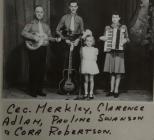 Credits:
Credits:Wingham Library, Wingham, Ontario
33
CKNX performers-Geo. Jordan, Archie Mann, Bill Simms, Don Robertson & Earl Heywood1940-1960
CKNX Radio and Television, Wingham, Ontario
 Credits:
Credits:Wingham Library, Wingham, Ontario
34
Ranch Boys-Archie Mann, Bill Mankiss, Don Robertson, Geo. Jordan, Ross Mann & Ernie King1935-1960s
CKNX Television & Radio station, Wingham, Ontario
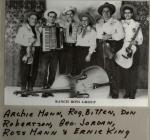 Credits:
Credits:Wingham Library, Wingham, Ontario
35
Johnny Brent broadcasting outside the original radio station on Josephine Street in Wingham.1935-1960
920 CKNX, Wingham, Ontario
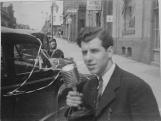 Credits:
Credits:North Huron Museum, Wingham, Ontario